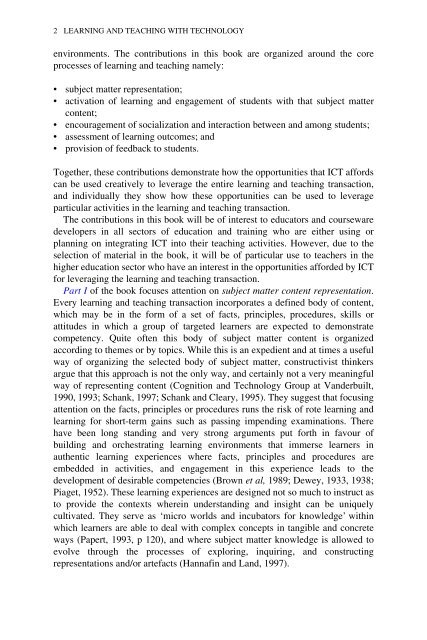teaching_and_learning_with_technology
teaching_and_learning_with_technology
teaching_and_learning_with_technology
You also want an ePaper? Increase the reach of your titles
YUMPU automatically turns print PDFs into web optimized ePapers that Google loves.
2 LEARNING AND TEACHING WITH TECHNOLOGY<br />
environments. The contributions in this book are organized around the core<br />
processes of <strong>learning</strong> <strong>and</strong> <strong>teaching</strong> namely:<br />
subject matter representation;<br />
activation of <strong>learning</strong> <strong>and</strong> engagement of students <strong>with</strong> that subject matter<br />
content;<br />
encouragement of socialization <strong>and</strong> interaction between <strong>and</strong> among students;<br />
assessment of <strong>learning</strong> outcomes; <strong>and</strong><br />
provision of feedback to students.<br />
Together, these contributions demonstrate how the opportunities that ICT affords<br />
can be used creatively to leverage the entire <strong>learning</strong> <strong>and</strong> <strong>teaching</strong> transaction,<br />
<strong>and</strong> individually they show how these opportunities can be used to leverage<br />
particular activities in the <strong>learning</strong> <strong>and</strong> <strong>teaching</strong> transaction.<br />
The contributions in this book will be of interest to educators <strong>and</strong> courseware<br />
developers in all sectors of education <strong>and</strong> training who are either using or<br />
planning on integrating ICT into their <strong>teaching</strong> activities. However, due to the<br />
selection of material in the book, it will be of particular use to teachers in the<br />
higher education sector who have an interest in the opportunities afforded by ICT<br />
for leveraging the <strong>learning</strong> <strong>and</strong> <strong>teaching</strong> transaction.<br />
Part I of the book focuses attention on subject matter content representation.<br />
Every <strong>learning</strong> <strong>and</strong> <strong>teaching</strong> transaction incorporates a defined body of content,<br />
which may be in the form of a set of facts, principles, procedures, skills or<br />
attitudes in which a group of targeted learners are expected to demonstrate<br />
competency. Quite often this body of subject matter content is organized<br />
according to themes or by topics. While this is an expedient <strong>and</strong> at times a useful<br />
way of organizing the selected body of subject matter, constructivist thinkers<br />
argue that this approach is not the only way, <strong>and</strong> certainly not a very meaningful<br />
way of representing content (Cognition <strong>and</strong> Technology Group at V<strong>and</strong>erbuilt,<br />
1990, 1993; Schank, 1997; Schank <strong>and</strong> Cleary, 1995). They suggest that focusing<br />
attention on the facts, principles or procedures runs the risk of rote <strong>learning</strong> <strong>and</strong><br />
<strong>learning</strong> for short-term gains such as passing impending examinations. There<br />
have been long st<strong>and</strong>ing <strong>and</strong> very strong arguments put forth in favour of<br />
building <strong>and</strong> orchestrating <strong>learning</strong> environments that immerse learners in<br />
authentic <strong>learning</strong> experiences where facts, principles <strong>and</strong> procedures are<br />
embedded in activities, <strong>and</strong> engagement in this experience leads to the<br />
development of desirable competencies (Brown et al, 1989; Dewey, 1933, 1938;<br />
Piaget, 1952). These <strong>learning</strong> experiences are designed not so much to instruct as<br />
to provide the contexts wherein underst<strong>and</strong>ing <strong>and</strong> insight can be uniquely<br />
cultivated. They serve as ‘micro worlds <strong>and</strong> incubators for knowledge’ <strong>with</strong>in<br />
which learners are able to deal <strong>with</strong> complex concepts in tangible <strong>and</strong> concrete<br />
ways (Papert, 1993, p 120), <strong>and</strong> where subject matter knowledge is allowed to<br />
evolve through the processes of exploring, inquiring, <strong>and</strong> constructing<br />
representations <strong>and</strong>/or artefacts (Hannafin <strong>and</strong> L<strong>and</strong>, 1997).


